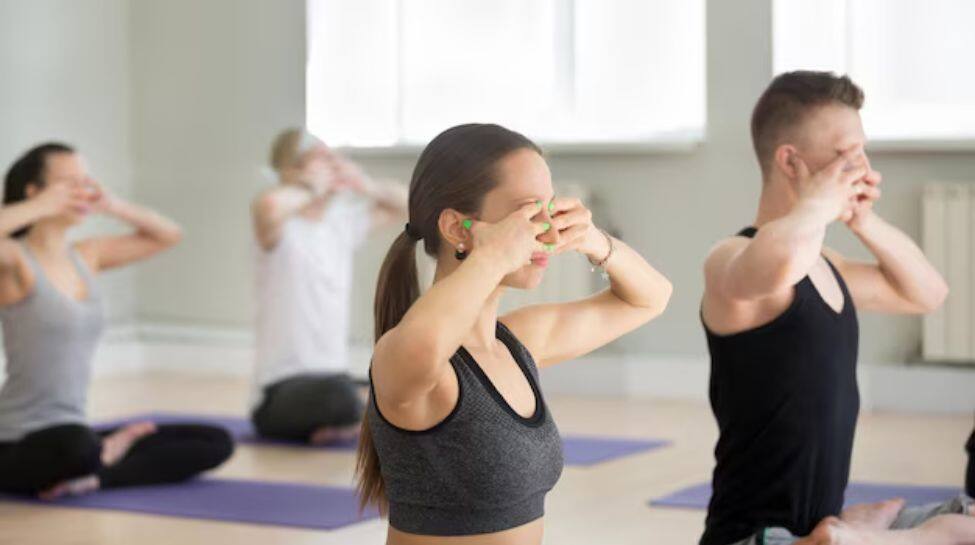Air Pollution: 8 Breathing Exercises To Practice At Home For Better Lung Health
Breathing clean air isn’t always in our control, but we can strengthen our lungs to minimize the harmful effects of air pollution. Discover 8 simple breathing exercises that you can practice at home to improve your lung health and overall well-being.
8 Breathing Exercises To Practice At Home For Better Lung Health
)
Air pollution may be unavoidable, but you can take charge of your lung health by practicing these exercises regularly.Incorporate these simple habits into your daily routine to protect yourself and breathe easier.Swipe up to explore more tips on combating air pollution and building resilience!
Diaphragmatic Breathing (Belly Breathing)

How to Do It: Sit or lie down comfortably. Place one hand on your chest and the other on your belly. Breathe in deeply through your nose, allowing your belly to rise. Exhale slowly through pursed lips, feeling your belly fall.
Why It’s Important: This technique strengthens the diaphragm and increases oxygen flow, helping your lungs function more efficiently. It’s especially beneficial for those with respiratory issues like asthma.
Pursed-Lip Breathing

How to Do It: Inhale slowly through your nose for about 2 seconds. Pucker your lips, as if you’re about to whistle, and exhale gently through them for about 4 seconds.
Why It’s Important: This exercise slows down your breathing, improves oxygen exchange, and helps you breathe more easily, especially during high-pollution days.
Anulom Vilom (Alternate Nostril Breathing)

How to Do It: Sit in a comfortable position. Close your right nostril with your thumb, and inhale deeply through your left nostril. Close the left nostril with your ring finger, and exhale through the right. Repeat for 5–10 minutes.
Why It’s Important: This calming technique cleanses the respiratory system, enhances lung capacity, and promotes mental clarity.
Equal Breathing (Sama Vritti)

How to Do It: Inhale deeply through your nose while counting to 4. Hold your breath for 4 counts, then exhale for 4 counts. Repeat for several cycles.
Why It’s Important: Sama Vritti balances your breathing rhythm, reduces anxiety, and promotes optimal lung health by ensuring consistent oxygen intake.
Bhramari (Humming Bee Breath)

How to Do It: Sit comfortably and inhale deeply through your nose. As you exhale, make a humming sound, similar to a bee buzzing. Focus on the vibrations in your throat.
Why It’s Important: The vibrations help relax your throat muscles and clear the airways, enhancing oxygen flow while calming your mind.
Lion’s Breath (Simhasana)

How to Do It: Kneel or sit comfortably. Inhale deeply through your nose, then open your mouth wide, stick out your tongue, and exhale forcefully while making a “ha” sound. Repeat 5–7 times.
Why It’s Important: This exercise clears mucus and toxins from the respiratory tract while boosting circulation to your lungs and throat.
Box Breathing

How to Do It: Inhale for 4 counts, hold your breath for 4 counts, exhale for 4 counts, and hold again for 4 counts before starting over.
Why It’s Important: This controlled breathing technique helps strengthen your lungs, regulate breathing patterns, and calm the nervous system.
Kapalabhati (Skull Shining Breath)

How to Do It: Sit comfortably with your back straight. Inhale deeply, then exhale quickly and forcefully through your nose while pulling your abdomen in. Continue the exhalation for 15–20 repetitions.
Why It’s Important: This advanced yogic exercise detoxifies your lungs, improves oxygen circulation, and energizes your entire respiratory system.
(This article is intended for your general information only. Zee News does not vouch for its accuracy or reliability.)
Trending Photos








